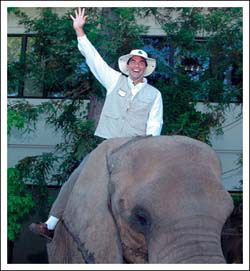Spread the Wealth: The Gasparilla Experiment
 In honor of FAQFriday, this post is about a bunch of questions our society wrestles with daily. I hope the example I share doesn't trivialize the magnitude of the questions...although I usually try to answer questions on FAQFriday, I'm the one asking today -- and I expect some answers!
In honor of FAQFriday, this post is about a bunch of questions our society wrestles with daily. I hope the example I share doesn't trivialize the magnitude of the questions...although I usually try to answer questions on FAQFriday, I'm the one asking today -- and I expect some answers!Last weekend my family drove down to Tampa to see the Gasparilla Parade (there's another next weekend). Having grown up in Tampa, attending the parade is a 30+ year tradition for me and we always have a great time. This year was a bit different, though. Both of my daughters had the opportunity to walk in the parade so my wife and I watched with our extended family. We had a blast, but without my daughters sitting with me I found myself paying closer attention to the capitalism vs. socialism struggle around parade seating.
You see, my family has always been the type to arrive early (10am) and create a great viewing area for the parade (3pm). Because we arrive early, we reserve parade-side seating in a chair-encircled area about 10 feet deep and 20 feet wide. We set out lawn chairs, blankets and coolers in anticipation of a full day of family, floats and fun -- and beads!
If you've ever been to a parade as well attended as Gasparilla (half-a-million people), you may sense where this is headed...
Between 10am and 1pm, thousands of other parade goers arrive and follow the same tradition, with chairs, blankets, coolers, and family -- creating a crowd of 50,000 about one-family deep along the entire route. I'll call this group the "early-arrivers" class because they sacrificed their morning, arrived early and created a comfortable space for their families.
Then, between 1pm and the parade's 3pm start, the other 450,000 people show up. I'll call this group the "late-arrivers" class. The earliest of these are probably a "middle-class" of parade space who don't get front-row seats, but still have decent space in between the early-arrivers and late-arrivers flowing in as the parade starts.
So what do you think happens?
First, the late-arrivers almost immediately start swallowing the middle-class because of their sheer numbers and because the middle-class didn't arrive early enough to secure their space from plunder. That equalizes and aligns everyone off-street, envying the prime space held by the early-arrivers -- even though the floats are large enough to be seen by all classes and there will be more parade beads thrown, to all classes, than anyone cares to keep. Then, for the rest of the parade, it's open class warfare as the late-arriver masses slowly consume the prime viewing areas created by the early-arrivers.
It starts with the late-arrivers trotting out their saddest cases for "spreading the wealth" -- their smallest kids. This is a very successful tactic, as most early-arrivers voluntarily reduce space for their own kids to pack the curb with the newcomers -- even though it significantly alters the experience from a comfortable family gathering. Then, once their kids have space, the late-arriver adults either wedge themselves behind/beside their kids or they begin the drum-beat of "spreading the wealth" with others -- full-scale class warfare is at hand. While some battle with words, many others physically start moving chairs, coolers, blankets to take more space. As some do it, it emboldens others until...eventually...the wealth has been spread to all. The parade ends with the late-arrivers having equal (sometimes better) space as the early-arrivers and the early-arrivers trying to find the lid to their cooler that was successively kicked behind the masses.
Although we had a great day watching the parade, catching beads and seeing our girls walk by in the parade (they actually missed us because they didn't recognize our mixed group of family and late-arrivers), this social experiment was really intriguing to watch unfold. It crystallized, for me, a few observations and questions about society:
1) Why do the late-arrivers feel this is "OK" or appropriate behavior to teach their kids? What do kids from each class learn from it?
2) How would it all change if parade goers weren't just splitting confined space, but early-arrivers actually "created" space by their arrival (more analogous to how entrepreneurs create jobs and wealth in society)? Would the late-arrivers feel any more or less entitled to equal space?
3) Does any of this feel different if we just change the labels from "early-arriver" to "rich" and "late-arriver" to "poor"?
4) How would it all change if there was a governing entity who announced that the early-arrivers were expected/required to share with the late-arrivers -- the more you have, the more you have to share? Would it reduce the number of early-arrivers? Would it cause late-arrivers to be even more brazen in their takeover, because the "spread the wealth" mindset was sanctioned from above?
5) What would happen if everyone, early and late arrivers, voted just before the parade started on how to split the space and the majority ruled? Would such a vote alter people's behavior in future years?
6) There will always be more late-arrivers than early-arrivers, it's the nature of people and a bell-curve of personalities.
7) Is this one-day experiment an accelerated view of what brings down societies over hundreds or thousands of years? Is "parade day" coming for the world, with its own distribution of "early-arrivers" and "late-arrivers"?
Labels: capitalism, class warfare, faqfriday, gasparilla, share the wealth, socialism, spread the wealth










